The Plague of Justinian has been associated with the extreme weather events of 535–536 AD which [in its turn] has been associated with “debris from space impacting the Earth”.
The extreme weather events of 535–536 were the most severe and protracted short-term episodes of cooling in the Northern Hemisphere in the last 2,000 years.
The event is thought to have been caused by an extensive atmospheric dust veil, possibly resulting from a large volcanic eruption in the tropics, and/or debris from space impacting the Earth.
Its effects were widespread, causing unseasonal weather, crop failures, and famines worldwide.
https://en.wikipedia.org/wiki/Extreme_weather_events_of_535%E2%80%93536
The Plague of Justinian (541–542) was a pandemic that afflicted the Eastern Roman (Byzantine) Empire, especially its capital Constantinople, the Sassanid Empire, and port cities around the entire Mediterranean Sea.
One of the greatest plagues in history, this devastating pandemic resulted in the deaths of an estimated 25 million (initial outbreak) to 50 million (two centuries of recurrence) people.
Recent investigations relate this severe plague epidemic to extreme weather events of 535–536 considered as an example of volcanic winter.
In a wonderful YouTube video Ruth Dwyer examines the Ravenna Mosaics and discovers the mosaics clearly depict “debris from space impacting the Earth”.
Ravenna is the capital city of the Province of Ravenna, in the Emilia-Romagna region of Italy.
It was the capital city of the Western Roman Empire from 402 until that empire collapsed in 476.
It then served as the capital of the Kingdom of the Ostrogoths until it was re-conquered in 540 by the Eastern Roman (Byzantine) Empire.
Afterwards, the city formed the centre of the Byzantine Exarchate of Ravenna until the invasion of the Franks in 751, after which it became the seat of the Kingdom of the Lombards.
Ruth Dwyer finds [amongst other things] that the Ravenna Mosaics depict: fiery clouds, shock waves, raining fire and a blue Sun.
Fiery Clouds
Shock Waves
Raining Fire
Blue Sun
Ruth Dwyer also finds that many of these phenomena were documented by contemporary authors.
25. Senator, Praetorian Praefect, to his Deputy Ambrosius, an Illustris.
[This letter appears to have been written in the early autumn of 538, about a year after the three last letters, and also after Letters 27 and 28, which precede it in order of date, though they follow it in this collection. For an account of the terrible famine in Italy, the beginning of which is here described, see Procopius, De Bello Gotthico ii. 20.]
Famine in Italy
‘Since the world is not governed by chance, but by a Divine Ruler who does not change His purposes at random, men are alarmed, and naturally alarmed, at the extraordinary signs in the heavens, and ask with anxious hearts what events these may portend.
The Sun, first of stars, seems to have lost his wonted light, and appears of a bluish colour.
We marvel to see no shadows of our bodies at noon, to feel the mighty vigour of his heat wasted into feebleness, and the phenomena which accompany a transitory eclipse prolonged through a whole year.
‘ The Moon too, even when her orb is full, is empty of her natural splendour.
Strange has been the course of the year thus far.
We have had a winter without storms, a spring without mildness, and a summer without heat.
Whence can we look for harvest, since the months which should have been maturing the corn have been chilled by Boreas ?
How can the blade open if rain, the mother of all fertility, is denied to it ?
These two influences, prolonged frost and unseasonable drought, must be adverse to all things that grow.
The seasons seem to be all jumbled up together, and the fruits, which were wont to be formed by gentle showers, cannot be looked for from the parched earth.
But as last year was one that boasted of an exceptionally abundant harvest, you are to collect all of its fruits that you can, and store them up for the coming months of scarcity, for which it is well able to provide.
And that you may not be too much distressed by the signs in the heavens of which I have spoken, return to the consideration of Nature, and apprehend the reason of that which makes the vulgar gape with wonder.
‘ The middle air is thickened by the rigour of snow and rarefied by the beams of the Sun.
This is the great Inane, roaming between the heavens and the earth.
When it happens to be pure and lighted up by the rays of the sun it opens out its true aspect ; but when alien elements are blended with it, it is stretched like a hide across the sky, and suffers neither the true colours of the heavenly bodies to appear nor their proper warmth to penetrate.
This often happens in cloudy weather for a time ; it is only its extraordinary prolongation which has produced these disastrous effects, causing the reaper to fear a new frost in harvest, making the apples to harden when they should grow ripe, souring the old age of the grape-cluster.
‘All this, however, though it would be wrong to construe it as an omen of Divine wrath, cannot but have an injurious effect on the fruits of the earth.
Let it be your care to see that the scarcity of this one year does not bring ruin on us all.
Even thus was it ordained by the first occupant of our present dignity, that the preceding plenty should avail to mitigate the present penury.’
The letters of Cassiodorus – Translated by Thomas Hodgkin – 1886 – Page 518
https://archive.org/details/letterscassiodo00hodggoog
However, after a nudge from CW, I took a closer look and noticed the Ravenna Mosaics also contain a very clear indication that the “debris from space” was “coming on us from the stars” in the Taurus constellation.
Taurus is one of the constellations of the zodiac, which means it is crossed by the plane of the ecliptic.
Taurus is a large and prominent constellation in the northern hemisphere’s winter sky.
It is one of the oldest constellations, dating back to at least the Early Bronze Age when it marked the location of the Sun during the spring equinox.
Its importance to the agricultural calendar influenced various bull figures in the mythologies of Ancient Sumer, Akkad, Assyria, Babylon, Egypt, Greece, and Rome.
Unsurprisingly, the Taurus constellation is associated with the annual Taurids Meteor Shower which is linked to Comet Encke [orbital period: 3.3 years] that is believed to be remnants of a much larger comet which has disintegrated.
A meteor shower is a celestial event in which a number of meteors are observed to radiate, or originate, from one point in the night sky.
These meteors are caused by streams of cosmic debris called meteoroids entering Earth’s atmosphere at extremely high speeds on parallel trajectories.
https://en.wikipedia.org/wiki/Meteor_shower
The Taurids are an annual meteor shower associated with the comet Encke.
They are named after their radiant point in the constellation Taurus, where they are seen to come from in the sky.
Because of their occurrence in late October and early November, they are also called Halloween fireballs.
Encke and the Taurids are believed to be remnants of a much larger comet, which has disintegrated over the past 20,000 to 30,000 years, breaking into several pieces and releasing material by normal cometary activity or perhaps occasionally by close encounters with the tidal force of Earth or other planets (Whipple, 1940; Klačka, 1999).
In total, this stream of matter is the largest in the inner solar system.
Since the meteor stream is rather spread out in space, Earth takes several weeks to pass through it, causing an extended period of meteor activity, compared with the much smaller periods of activity in other showers.
The Taurids are also made up of weightier material, pebbles instead of dust grains.
https://en.wikipedia.org/wiki/Taurids
Comet Encke or Encke’s Comet (official designation: 2P/Encke) is a periodic comet that completes an orbit of the Sun once every 3.3 years.
…
Comet Encke is believed to be the originator of several related meteor showers known as the Taurids (which are encountered as the Northern and Southern Taurids across November, and the Beta Taurids in late June and early July).
But given the orbit of Comet Encke its origins are far more likely associated with a planetary explosion that occurred in the Titius–Bode Gap between Mars and Jupiter.
However, an examination of the Jupiter-family trajectories clearly indicates a convergence point [just beyond the current orbit of Mars] which strongly suggests these comets had an explosive origin in the very recent astronomical past.
See: The Other Big Bang Theory
Either way, its worth taking another look at the temperature record used by Ruth Dwyer in her The Comet of 536 and the Ravenna Mosaics video [at 12:07] to see if there is any evidence of a very short period comet or the disintegration of a short period comet.
The first important observation based upon this temperature record [starting in 500 AD] is that there is a pronounced 6.3 year oscillation running across the entire 100 year record.
The second important observation based upon this temperature record is that beginning around 535 AD there is pronounced 8.7 year oscillation that is propagated across the remainder of the period.
The implications of these observations are:
1) A short period comet [possibly related to Comet Encke] catastrophically divided around 535 AD.
2) The incoming debris stream was particularly intense when the comets coincided e.g. 545, 570 and 596 AD.
3) The comets continued to impact temperatures beyond the end of the displayed time period and the Old Japanese Cedar indicates global temperatures didn’t recover until around 670 AD.
4) The recovery of temperatures by 670 AD suggests one [or both] of these cometary fragments had completely disintegrated by this date and this timing coincides with the development of the Middle Sand Unit in the Denver Basin.
The middle sand unit (unit 3b, figs. 7, 11) was deposited between about 1275 and 930 years ago (A.D.675 and 1020).
Distribution of Late Quaternary Wind-Deposited Sand in Eastern Colorado
R.F Madole, D.P. VanSistine and J.A. Michael – 2005
U.S. Geological Survey Scientific Investigations Map 2875
In other words:
The Justinian Comet of 535 AD ushered in a period of about 135 years during which Justinian’s Raging Bulls wreaked havoc across the globe.
See: Mesoamerican Guide to the First Millennium
UPDATE 1st October 2016
The narrative continues with the Year of the Elephant.
See: https://malagabay.wordpress.com/2016/10/01/the-arabian-horizon-the-year-of-the-elephant/
FOOTNOTE ONE
Modern interest in the destructive capabilities of the Taurid complex can be traced back to the 1982 publication of The Cosmic Serpent by Victor Clube and William Napier.
In 1982, two British astronomers, S. V. M (Victor) Clube and William Napier, published a book entitled The Cosmic Serpent.
Clube and Napier suggested that the outer planets occasionally divert giant comets (more than 50 kilometers in diameter) into the inner solar system into short-period orbits.
Debris from the resultant disintegration of these giant comets can adversely affect the environment of the Earth.
Dusting can block sunlight, resulting in globally cooler conditions.
Impact events in the super-Tunguska class may result in not only heavy localized destruction but also the occasional “impact winter” or dust veil with global climatological effects.
Clube and Napier identified the progenitor of the Taurid complex as such a giant comet whose injection into a short-period (about 3.3 year) orbit occurred sometime in the last twenty to thirty thousand years.
The Taurid complex currently includes the Taurid meteor stream, Comet Encke (the only known currently active comet in the Taurid complex), “asteroids” such as 2101 Adonis and 2201 Oljato, and copious amounts of dust.
All ten of the numbered asteroids in the Taurid complex appear to have associated meteor showers and therefore are likely to be extinct comets masquerading as asteroids.
Philip R. “Pib” Burns – Clube and Napier: Coherent Catastrophism – 2009
https://www.pibburns.com/catastro/clubenap.htmIn their 1982 book Cosmic Serpent (page 155) Victor Clube and Bill Napier reproduce an ancient Chinese catalogue of cometary shapes from the Mawangdui Silk Texts, which includes a swastika-shaped comet, and suggest that some comet drawings were related to the breakup of the progenitor of Encke and the Taurid meteoroid stream.
FOOTNOTE TWO
A useful by-product of this analysis is that it provides a couple of data resolution dependent signatures that may help identify the catastrophic division of a comet in other chronologies.


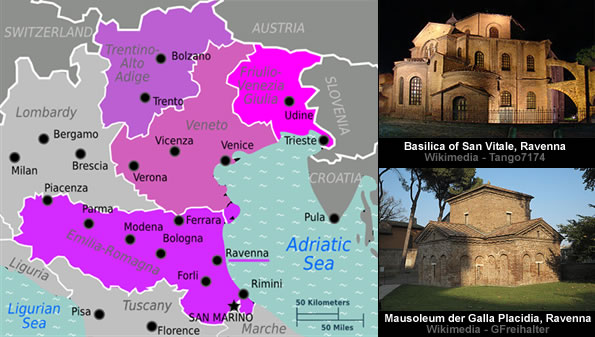

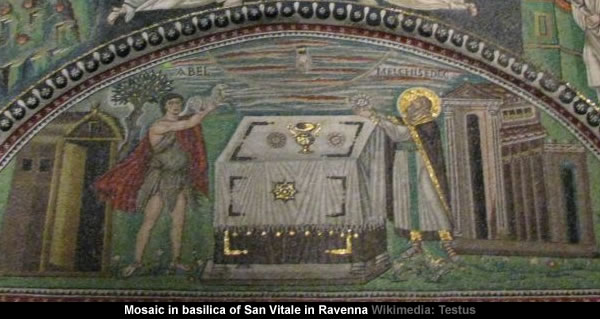
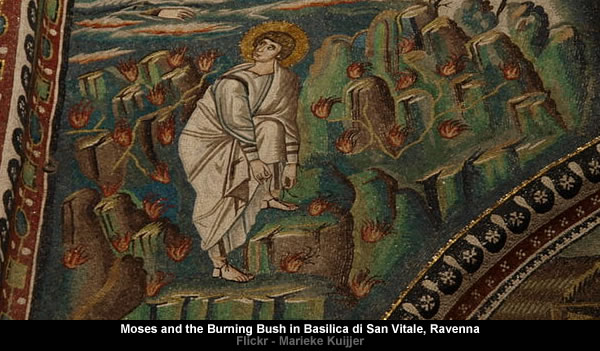
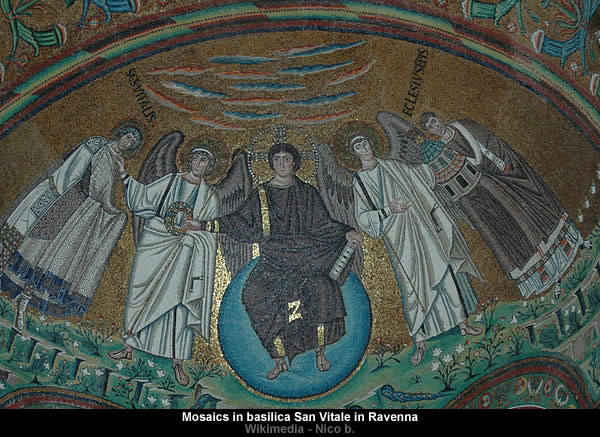
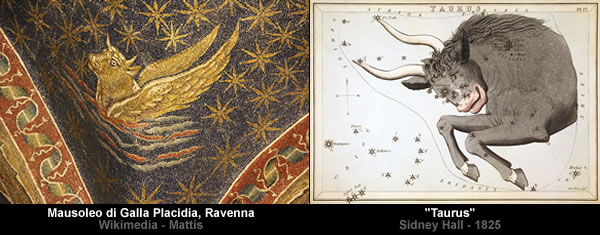
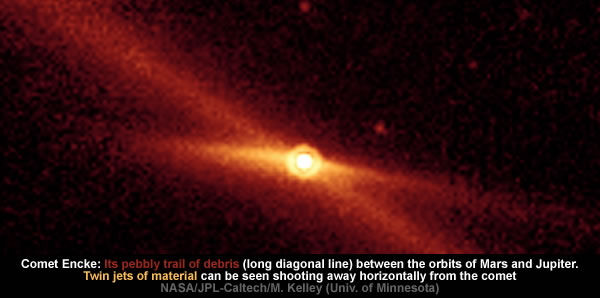
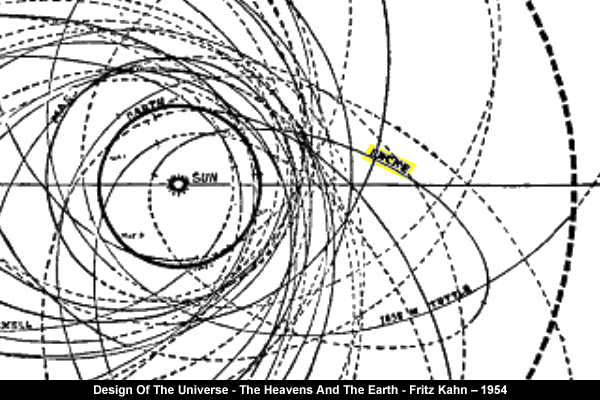
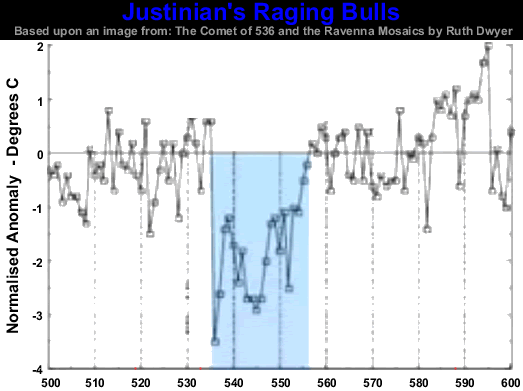
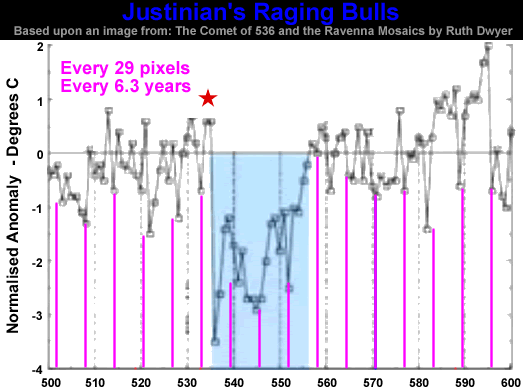
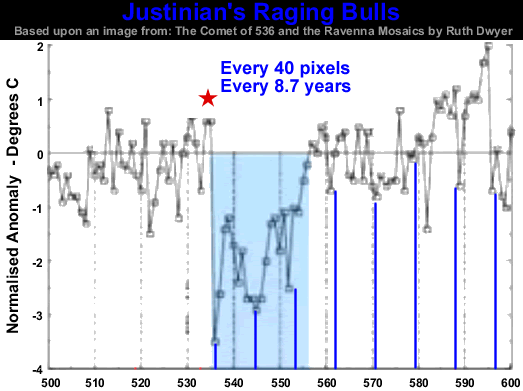
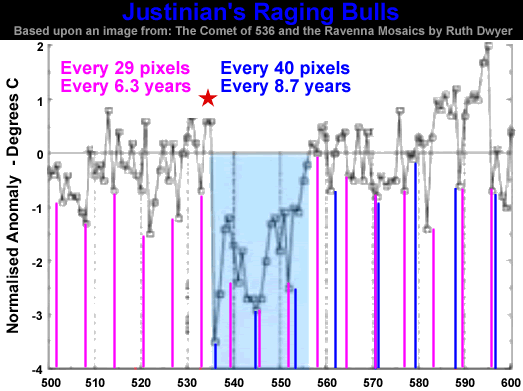
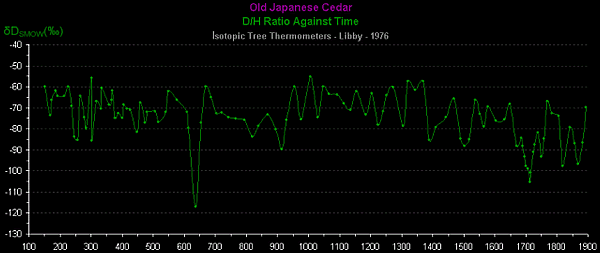
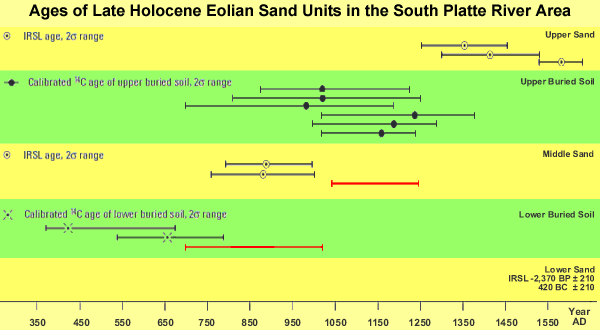

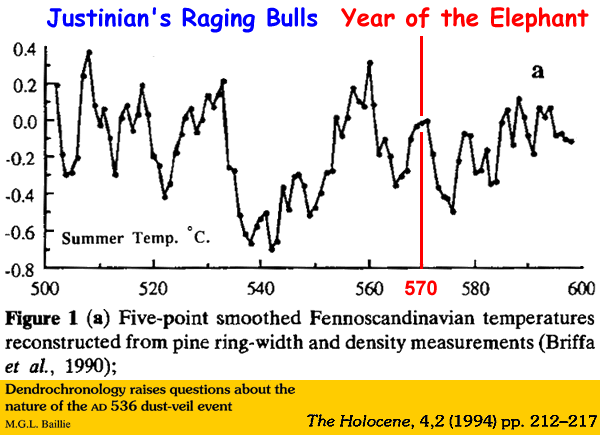

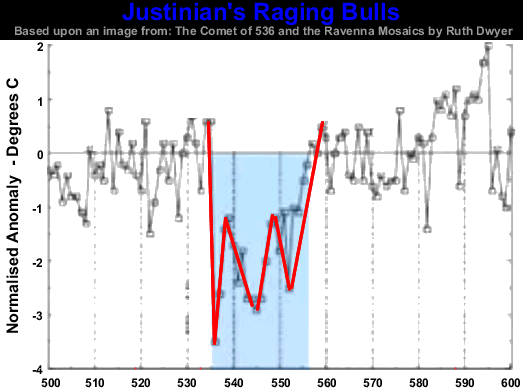
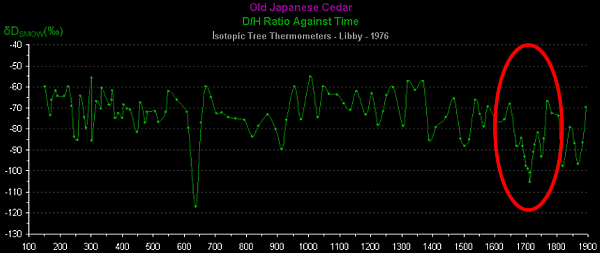
Excellent! One of MalagaBay’s best.
Pingback: The Little Ice Age | MalagaBay
Pingback: The Roman Time Line and the Heinsohn Horizon | MalagaBay
Pingback: The Wroxeter Chronicles: Broken Red Sandstone | MalagaBay
Pingback: Comets and the Early Christian Mosaics of Revenna, Italy « The Cosmic Tusk
Pingback: Petroglyphs, Plasma and Comets | Louis Hissink's Crazy World
Pingback: The Arabian Horizon: The Year of the Elephant | MalagaBay
Pingback: The Arabian Horizon: The Heinsohn Sandwich | MalagaBay
Pingback: 535 – 536년의 극단적인 기후 사건 – Yellow의 블로그
Pingback: Plague of Justinian | MalagaBay
This is the first I have heard that Sol attained Blue status!
Very significant, if true. W Thornhill has said that stars nova when they can no longer stand the load imposed on them.
Having a blue stage will give those of us with awareness the short time required to prepare. We may still not survive, but preparation will be key.
But what actual BP is this date? Not every nova will result in expulsion of a planet. But the ascent and then discharge will cause magnetic reversals by physical adjustments, expansions and CAT Astro phe….
The sun did not physically become blue, it appeared a bluish color due to ash in the air, which darkened the sun and moon, and caused global cooling.
The sun is also not the type of star that would go supernova/nova; instead, it is expected to shed its outer layers (creating a solar nebula and leaving behind a white dwarf) about 5-7 billion years from now.
No need to worry about a catastrophic exploding-sun event 🙂
536CE is near the root of an Eddy cycle. Eddy cycle is 975+/- 50 years. Why not exact is ????, but may be that it is controlled by more than one fundamental driver. Roots can be traced back from near 1700CE – Little ice age- to the 6200BCE event. The first five were cataclysmic. The latter five can all be associated with a today known civilization collapse.
Much of the phenomena witnessed were secondary collateral events. In many ways those events release the Four Horsemen of the Apo.
2345BCE is near one such date. GF Dodwell first pointed out an earth obliquity change at that date. Looking at a paper from John Eddy’s contributions to science, it appears he was concerned about obliquity, but seems to have distanced himself from it (I got the feeling that he knew what happened the Dodwell and stayed clear).
Review/reply of John Eddy’s book here at pg 30 (long read) http://www.dioi.org/vols/w11.pdf – long read.
Note: proof that Dodwell was precise is today ‘writ in stone’, an alteration in a megalithic calendar that gives both earth tilt value, before and after. Eddy had good reason to act as he did.